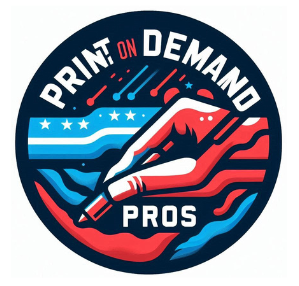Font choice can make or break your design in the world of print on demand. It’s like picking the right soundtrack for a movie scene. You want something that enhances the narrative without stealing the spotlight. Picking the right font sets the mood and captures your brand’s vibe, influencing how customers perceive your products.
When customers see your product, the font can subtly communicate your brand’s voice, from playful to professional. Imagine a mug with bold, quirky letters. It sends a different message than the same mug using sleek, script-style typography. Your font choice can turn a casual browser into a committed buyer, so it’s essential to choose wisely.
With print on demand, you have countless opportunities to experiment and differentiate your products. The right font can be your secret weapon in standing out among the competition. Everyone may have similar products, but your font choice can be the unique twist that sets your items apart. This is your chance to show off brand personality or the specific vibe you want your designs to have.
While it seems like a small detail, fonts are strategic tools in your branding kit. They can evoke emotions and build connections with your audience at first glance. Investing time in the right font selection can lead to better engagement and ultimately improve your sales.
Without letting the design world’s jargon get in the way, what’s crucial is balance. Your font should work harmoniously with other design elements, such as color schemes and images, to create a cohesive final product that’s as striking as it is meaningful.
Understanding Font Licensing: Safeguarding Your Business
Font licensing might sound like unnecessary bureaucracy for your print on demand ventures, but understanding it can protect your business from costly mistakes. Picture it as signing a rental agreement—you wouldn’t move into a place without sorting out the paperwork, right? The same principle applies to fonts.
Each font comes with its own set of rules, laid out in what’s usually called a license agreement. This document spells out how you can use the font, like whether you can use it in products you plan to sell or if it’s just for personal projects. These details aren’t just suggestions—they ensure you’re legally covered.
The most critical distinction to grasp is between personal and commercial use. Personal use means you can use the font for things like family birthday cards or personal scrapbooks. However, the minute you sell a product featuring that font, you cross into commercial territory, which usually requires a different license.
It’s easy to overlook this when you’re just starting or if you’re focused on the creative aspects of your designs. Yet, knowing these nuances is fundamental. Some fonts are labeled ‘free’, but that doesn’t necessarily mean free for commercial use. The devil is in the details, so always read the fine print.
Finally, if you’re overwhelmed with all these licensing issues, there are ways to play it safe. Opt for fonts that clearly state they’re free for commercial use or invest in licenses for premium fonts that suit your brand’s needs. That way, you can concentrate on the creative side of your business without risking legal hassles.
Risks of Using Unlicensed Fonts: Legal and Financial Implications
Using fonts without the proper licensing can lead to a world of trouble, and it’s not just legal jargon you can ignore. Imagine selling a t-shirt or mug with a cool custom font that everyone loves, but you didn’t check the font’s licensing agreement. You could end up in hot water, facing fines or other legal actions.
Font creators and distributors have the right to protect their intellectual property, which is what licenses are all about. Violating these agreements can result in lawsuits that not only drain your resources but also damage your brand’s reputation. Trust me, it’s not worth the headache.
In some cases, makers might send cease and desist notices, forcing you to halt your use commercially. This disrupts your sales flow and might even pull products from your inventory. Financial risks stack up alongside the legal ones, especially if a lawsuit demands monetary compensation.
While small-scale operations might slip under the radar, it’s not a risk you want to gamble on. Larger or more visible operations have been taken to court over font license breaches. Even as a smaller business, staying transparent about your font usage keeps your operations clean and worry-free.
Understanding the seriousness of these risks helps you appreciate the importance of using licensed fonts. It’s essential to have a game plan—stick to using fonts that clearly allow commercial use, or explore buying licenses to protect your business from unwarranted risks.
Navigating the Complexities of Attribution Requirements
Some fonts come with a little extra condition known as attribution, which means giving credit to the font creator. This might seem daunting in the world of tangible products, but it’s workable with a bit of creativity.
Attribution typically needs to appear somewhere visible to the consumer, like in a product description, packaging, or any promotional material. In digital products, this can be straightforward, but for physical items like a T-shirt, where do you fit in a ‘thank you’ note for the font?
Not every font enforces attribution in the same way, so it’s all about finding a practical solution that respects the font’s license. One option could be to include a brief credit in your online store product descriptions or even on a tag attached to the product. Sure, it’s a little extra work, but it keeps you within the legal lines.
Balancing legal compliance while maintaining product aesthetic and practicality is crucial. If you’re selling products at craft fairs or through non-digital platforms, incorporating attribution might require some brainstorming.
Some entrepreneurs choose to avoid attribution requirements altogether by selecting fonts that do not have these clauses. This can save time and simplify distribution across multiple sales platforms. The bottom line is to make sure your products shine without legal shadows hanging over them.
Adopting Best Practices for Font Use in POD Businesses
To keep your print on demand business clear of any font-related hitches, adopting a set of best practices is the way to go. Start by using fonts that explicitly permit commercial use. There are many available online, some free and others requiring a fee, but what matters is that they give you the freedom to sell without constraints.
Reading user agreements carefully is non-negotiable. This might seem tedious, like reading terms and conditions, but spending that little extra time upfront prevents major headaches down the road. Make sure you know exactly what you’re agreeing to.
If you want stress-free operations, open-source fonts can be a great choice. They’re typically free to use for any purpose, providing a safe zone without the licensing drama. There’s a solid selection out there, so you don’t have to sacrifice style thanks to options like Google Fonts.
Creating custom typography might sound expensive or complex, but it’s a great investment if you’re looking to cut away from the crowd. Designing a unique font gives your brand a distinctive edge and completely sidesteps licensing issues.
Remember, the key is not only to avoid trouble but to keep creativity flowing. When licensing isn’t a hurdle, you can focus more on developing designs that resonate with your audience, boosting your sales and your brand’s credibility in the process.




What a fascinating article! It’s a great reminder of how much impact font choice can have on design and branding, especially in the print-on-demand world. I completely agree that fonts are like the soundtrack of a design—they set the mood and tell a story.
The emphasis on font licensing is so important too. It’s something that’s easy to overlook but could save creators from serious legal and financial risks. I also love the idea of using custom typography to stand out—that’s such a powerful way to define a brand’s identity.
Thanks for shedding light on these aspects—definitely a must-read for anyone in the POD business!